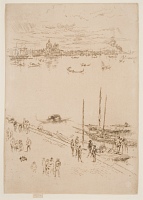Upright Venice | ||
| Number: | 232 | |
| Date: | 1879-1880 | |
| Medium: | etching and drypoint | |
| Size: | 255 x 180 mm | |
| Signed: | butterfly at lower left (3-final) | |
| Inscribed: | no | |
| Set/Publication: | 'Second Venice Set', 1886 | |
| No. of States: | 7 | |
| Known impressions: | 39 | |
| Catalogues: | K.205; M.202; W.172 | |
| Impressions taken from this plate (39) | ||
TECHNIQUE
This etching shows probably the most dramatic changes between the early and later states of all Whistler's etchings. The 'thin line' of the distant domes of Santa Maria della Salute and shipping were etched in first, exquisitely clear and sharp. In later states, Whistler created a strongly structured composition, with the diagonal line of the quayside cutting across the foreground, plus boats by the riva and groups of figures. This was sensitively printed, with a light film of ink wiped vertically to indicate water. The first state left much to the viewer's imagination, while the second state defines the boundaries of space.
PRINTING
The first rough proof, inked only at the top of the plate, was printed in black ink on cream wove paper ( ). One impression of the second state is printed in black on heavy-weight buff wove paper (
). One impression of the second state is printed in black on heavy-weight buff wove paper ( ). Another, in black, roughly wiped, is on off-white fairly heavy-weight laid paper with an eagle watermark, a sheet removed from a book, with deckled edges on three sides (
). Another, in black, roughly wiped, is on off-white fairly heavy-weight laid paper with an eagle watermark, a sheet removed from a book, with deckled edges on three sides ( ). Most early impressions were not trimmed.
). Most early impressions were not trimmed.
 ). One impression of the second state is printed in black on heavy-weight buff wove paper (
). One impression of the second state is printed in black on heavy-weight buff wove paper ( ). Another, in black, roughly wiped, is on off-white fairly heavy-weight laid paper with an eagle watermark, a sheet removed from a book, with deckled edges on three sides (
). Another, in black, roughly wiped, is on off-white fairly heavy-weight laid paper with an eagle watermark, a sheet removed from a book, with deckled edges on three sides ( ). Most early impressions were not trimmed.
). Most early impressions were not trimmed. A close friend and admirer of Whistler, Arthur Haythorne Studd (1863-1919), may have been helping to print the plate, and kept a torn fragment of the sixth state, printed in black ink, which he later bequeathed to the British Museum ( ).
).
 ).
).When Whistler was satisfied with the copper plate he submitted it to the publishers, Messrs Dowdeswell and Alphonse Wyatt Thibaudeau (ca 1840- d.1892). They sent the plate to Émile Frédéric Salmon (1840-1913) to be printed by Émile Frédéric Salmon (1840-1913). He printed a good clear impression (reproduced above) of the fourth state in black ink with very light overall buff tone on dark cream paper ( ).
).
 ).
). Whistler, however, decided to print the plate himself. It was published with A Set of Twenty-six Etchings (the 'Second Venice Set') in 1886. It may be that impressions in dark brown ink (e.g.  ), or warm black ink, are his response to the cooler tone of Salmon's proof.
), or warm black ink, are his response to the cooler tone of Salmon's proof.
 ), or warm black ink, are his response to the cooler tone of Salmon's proof.
), or warm black ink, are his response to the cooler tone of Salmon's proof. The impression selected by Messrs Dowdeswell to present to the British Museum in 1887 (reproduced above) is in dark brown ink, delicately wiped, on ivory laid paper ( ). Other examples of printing in brown ink, with surface tone carefully wiped to enhance the effect of space and atmosphere, are on cream laid paper with Strasbourg Lily watermark (
). Other examples of printing in brown ink, with surface tone carefully wiped to enhance the effect of space and atmosphere, are on cream laid paper with Strasbourg Lily watermark ( ,
,  ), ivory 'antique' (pre-1800) laid paper with a post horn in shield watermark (
), ivory 'antique' (pre-1800) laid paper with a post horn in shield watermark ( ), and a buff 'antique' laid paper (
), and a buff 'antique' laid paper ( ).
).
 ). Other examples of printing in brown ink, with surface tone carefully wiped to enhance the effect of space and atmosphere, are on cream laid paper with Strasbourg Lily watermark (
). Other examples of printing in brown ink, with surface tone carefully wiped to enhance the effect of space and atmosphere, are on cream laid paper with Strasbourg Lily watermark ( ,
,  ), ivory 'antique' (pre-1800) laid paper with a post horn in shield watermark (
), ivory 'antique' (pre-1800) laid paper with a post horn in shield watermark ( ), and a buff 'antique' laid paper (
), and a buff 'antique' laid paper ( ).
). Two impressions of Upright Venice were delivered by Whistler to Messrs Dowdeswell on 22 July 1886, five on 20 August, seven on 26 October, eighteen on 15 December, four on 5 January 1887; two on 2 April and one on 3 April [1886], eight on 15 January 1887, a total of 47. 8
8: [16 July 1887], GUW #08717.


